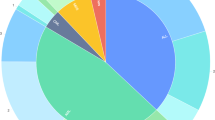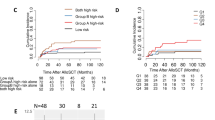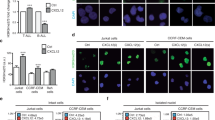Abstract
The interaction between CXCL12 and its receptor CXCR4 plays a crucial role in the homing and mobilization of haematopoietic progenitors. We investigated the putative association between a CXCL12 gene polymorphism, the G → A transition at position 801 in the 3′-untranslated region (3′UTR), and the yield of CD34+ progenitors in 65 healthy allogeneic transplant donors who received G-CSF. Importantly, in this setting, the analysis was not biased by background disease or chemotherapy. The 3′UTR CXCL12 G801A polymorphism was detected using a PCR-RFLP technique with the MspI restriction enzyme and the frequency of CD34+ progenitors was assessed by flow cytometry. The frequency as well as the number of CD34+ progenitor cells in the first leukapheresis product was significantly higher from donors with the CXCL12-3′A allele compared to GG homozygotes (P<0.05 in both cases), especially for subjects with the CXCL12-3′AA homozygous genotype (P<0.01 in both cases). Moreover, more leukaphereses were needed to obtain the required number of CD34+ progenitors for transplantation from CXCL12-3′GG homozygous donors compared to the CXCL12-3′A carriers (P=0.003). In conclusion, the CXCL12-3′A allele was associated with a higher yield of CD34+ cells from healthy donors of PBPC for allogeneic haematopoietic SCT.
This is a preview of subscription content, access via your institution
Access options
Subscribe to this journal
Receive 12 print issues and online access
$259.00 per year
only $21.58 per issue
Buy this article
- Purchase on SpringerLink
- Instant access to full article PDF
Prices may be subject to local taxes which are calculated during checkout


Similar content being viewed by others
References
Champlin RE, Schmitz N, Horowitz MM, Chapuis B, Chopra R, Cornelissen JJ et al. Blood stem cells compared with bone marrow as a source of hematopoietic cells for allogeneic transplantation: IBMTR Histocompatibility and Stem Cell Sources Working Committee and the European Group for Blood and Marrow Transplantation (EBMT). Blood 2000; 95: 3702–3709.
Dlubek D, Pacuszko T, Suchnicki K, Lange A . G-CSF-mobilized leukapheresis products: cellular characteristics and clinical performance in allografting. J Hematother 1999; 8: 157–166.
Lapidot T, Petit I . Current understanding of stem cell mobilization: the roles of chemokines, proteolytic enzymes, adhesion molecules, cytokines, and stromal cells. Exp Hematol 2002; 30: 973–981.
Papayannopoulou T . Current mechanistic scenarios in hematopoietic stem/progenitor cell mobilization. Blood 2004; 103: 1580–1585.
Jankowski K, Kucia M, Wysoczynski M, Reca R, Zhao D, Trzyna E et al. Both hepatocyte growth factor (HGF) and stromal-derived factor-1 regulate the metastatic behavior of human rhabdomyoscroma cells, but only HGF enhances their resistance to radiochemotherapy. Cancer Res 2003; 63: 7926–7935.
Levesque J-P, Bendall LJ, Hendy J, Takamatsu Y, Simmons PJ . Neutrophil enzymes degrade CXC4 on CD34++ progenitors: implications for progenitor cell mobilization. Blood 2002; 100: 107.
Gieryng A, Bogunia-Kubik K . The role of the SDF-1-CXCR4 axis in hematopoiesis and the mobilization of hematopoietic stem cells to peripheral blood. Postepy Hig Med Dosw 2007; 61: 369–383.
Burns JM, Summers BC, Wang Y, Melikian A, Berahovich R, Miao Z et al. A novel chemokine receptor for SDF-1 and I-TAC involved in cell survival, cell adhesion, and tumor development. J Exp Med 2006; 203: 2201–2213.
Shirozu M, Nakano T, Inazawa J, Tashiro K, Tada H, Shinohara T et al. Structure and chromosomal localization of the human stromal cell-derived factor-1 (SDF-1) gene. Genomics 1995; 28: 495–500.
Yu L, Cecil J, Peng SB, Schrementi J, Kovacevic S, Paul D et al. Identification and expression of novel isoforms of human stromal cell-derived factor 1. Gene 2006; 374: 174–179.
Winkler C, Modi W, Smith MW, Nelson GW, Wu X, Carrington M et al. Genetic restriction of AIDS pathogenesis by an SDF-1 chemokine gene variant. Science 1998; 279: 389–393.
Petit I, Szyper-Kravitz M, Nagler A, Lahav M, Peled A, Habler L et al. G-CSF induces stem cell mobilization by decreasing bone marrow SDF-1 and up-regulating CXCR4. Nat Immunol 2002; 3: 687–694.
Dlubek D, Drabczak-Skrzypek D, Lange A . Low CXCR4 membrane expression on CD34+ cells characterizes cells mobilized to blood. Bone Marrow Transplant 2006; 37: 19–23.
Christopherson KW, Cooper S, Broxmeyer HE . Cell surface peptidase CD26/DPPIV mediates G-CSF mobilization of mouse progenitor cells. Blood 2003; 101: 4680–4686.
Benboubker L, Herve W, Carion A, Georget M-M, Desbois I, Colombat P et al. Association between the SDF-1-3′A allele and high levels of CD34+ progenitor cells mobilized into peripheral blood in humans. Br J Haematol 2001; 113: 247–250.
Magierowska M, Lepage V, Boubnova L, Carcassi C, de Juan D, Djoulah S et al. Distribution of the CCR5 gene 32 base pair deletion and SDF1-3′A variant in healthy individuals from different populations. Immunogenetics 1998; 48: 417–419.
Aiuti A, Webb IJ, Bleul C, Springer T, Gutierrez-Ramos JC . The chemokine SDF-1 is a chemoattractant for human CD34+ hematopoietic progenitor cells and provides a new mechanism to explain the mobilization of CD34+ progenitors to peripheral blood. J Exp Med 1997; 185: 111–120.
Hattori K, Heissig B, Tashiro K, Honjo T, Tateno M, Shieh JH et al. Plasma elevation of stromal cell-derived factor-1 induces mobilization of mature and immature hematopoietic progenitor and stem cells. Blood 2001; 97: 3354–3360.
Gieryng A, Bogunia-Kubik K, Dlubek D, Duda D, Lange A . The presence of SDF1-3′A allele is associated with a higher mobilization yield of CD34+ progenitors to peripheral blood in healthy donors of allogeneic HSCT and patients undergoing autologous transplants. Tissue Antigens 2007; 69: S401.
Arya SK, Ginsberg CC, Davis-Warren A, D′Costa J . In vitro phenotype of SDF1 gene mutant that delays the onset of human immunodeficiency virus disease in vivo. J Hum Virol 1999; 2: 133–138.
Kimura R, Nishioka T, Ishida T . The SDF1-G801A polymorphism is not associated with SDF1 gene expression in Epstein-Barr virus-transformed lymphoblastoid cells. Genes Immun 2003; 4: 356–361.
Kimura R, Nishioka T, Soemantri A, Ishida T . Allele-specific transcript quantification detects haplotypic variation in the levels of the SDF-1 transcripts. Hum Mol Genet 2005; 14: 1579–1585.
Soriano A, Martinez C, Garcia F, Plana M, Palou E, Lejeune M et al. Plasma stromal cell-derived factor (SDF)-1 levels, SDF1-3′A genotype, and expression of CXCR4 on T lymphocytes: their impact on resistance to human immunodeficiency virus type 1 infection and its progression. J Infect Dis 2002; 186: 922–931.
Signoret N, Oldridge J, Pelchen-Matthews A, Klasse PJ, Tran T, Brass LF et al. Phorbol esters and SDF-1 induce rapid endocytosis and down modulation of the chemokine receptor CXCR4. J Cell Biol 1997; 139: 651–664.
Gazitt Y, Liu Q . Plasma levels of SDF-1 and expression of SDF-1 receptor on CD34+ cells in mobilized peripheral blood of non-Hodgkin′s lymphoma patients. Stem Cells 2001; 19: 37–45.
Carion A, Benboubker L, Herault O, Roingeard F, Degenne M, Senecal D et al. Stromal-derived factor 1 and matrix metalloproteinase 9 levels in bone marrow and peripheral blood of patients mobilized by granulocyte colony-stimulating factor and chemotherapy. Relationship with mobilizing capacity of haematopoietic progenitor cells. Br J Haematol 2003; 122: 918–926.
Temple SE, Pham K, Glendenning P, Phillips M, Waterer GW . Endotoxin induced TNF and IL-10 mRNA production is higher in male than female donors: correlation with elevated expression of TLR4. Cell Immunol 2008; 251: 69–71.
Acknowledgements
We especially thank Danuta Sosnowska from the Cytopheresis Unit of the Lower Silesian Center for Cellular Transplantation for her help in collecting the donors’ data.
This work was supported by grants from the Polish Ministry of Science and Higher Education (2 PO5B 085 28, N N401 008035 and N N402 193335) and the FP6 Grant AlloStem (LSHB-CT-2004-503319).
Author information
Authors and Affiliations
Corresponding author
Rights and permissions
About this article
Cite this article
Bogunia-Kubik, K., Gieryng, A., Dlubek, D. et al. The CXCL12-3′A allele is associated with a higher mobilization yield of CD34 progenitors to the peripheral blood of healthy donors for allogeneic transplantation. Bone Marrow Transplant 44, 273–278 (2009). https://doi.org/10.1038/bmt.2009.30
Received:
Revised:
Accepted:
Published:
Issue date:
DOI: https://doi.org/10.1038/bmt.2009.30
Keywords
This article is cited by
-
Salvage treatment with plerixafor in poor mobilizing allogeneic stem cell donors: results of a prospective phase II-trial
Bone Marrow Transplantation (2021)
-
Donor-intrinsic variables determine mobilization efficiency: analyses from a cohort of sixty twice-mobilized stem cell donors
Journal of Translational Medicine (2020)
-
Mobilization of hematopoietic stem and progenitor cells using inhibitors of CXCR4 and VLA-4
Leukemia (2012)
-
Ancestim (r-metHuSCF) plus filgrastim and/or chemotherapy for mobilization of blood progenitors in 513 poorly mobilizing cancer patients: the French compassionate experience
Bone Marrow Transplantation (2011)



